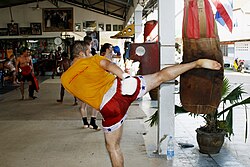
Thai and Cambodian ethnicity indicates genetic origins in southeast Asia encompassing Thailand and Cambodia and including areas of Vietnam, Laos, Myanmar, and Malaysia. The countries of Thailand (formerly known as Siam) and Cambodia are located on the Indochinese Peninsula in Southeast Asia. For thousands of years, the region has been home to various indigenous groups. Thai people are the dominant ethnicity in central and southern Thailand. Other Tai peoples, such as the Dai, Isan, Shan, Lao, Ahom, and Northern Thai, can be found in Thailand and neighboring countries, such as Myanmar, Burma, and Laos, as well as in eastern India and southeast China. Making up 97% of the country’s population, Khmer people are the overwhelming majority in Cambodia, but can also be found in regions of Thailand and Vietnam. While Theravada Buddhism is common among Thais, Cambodians mostly adhere to the Khmer style of Buddhism, which blends elements of Theravada Buddhism, Hinduism, animism, and veneration of the dead. Thai and Cambodian nationals have immigrated and formed communities in North America, western Europe, Australia, the Middle East, and other countries in Southeast Asia.
Research your ancestors on MyHeritage
Thai and Cambodian history

The area of modern Thailand was historically inhabited by a number of indigenous Mon-Khmer and Malay civilizations. Around the tenth century C.E., predecessors of modern Thai people first migrated into the region from southeast China. At that time, the region was part of the broader Khmer Empire, which dominated most of Southeast Asia from its capital in Angkor, in present-day Cambodia. The Khmer Empire, established in 802 C.E., emerged out of the remnants of Chenla, an Indianized state in Cambodia which — together with its predecessor state, Funan — had tremendous cultural influence over all of Southeast Asia.
In the thirteen century, a local Thai ruler rallied his people to rebel against the Khmer, and successfully carved out the Sukhothai Kingdom — the first independent Thai state. The Sukhothai period saw the adoption of Theravada Buddhism and the creation of what would become the modern Thai script. In the fifteenth century, the Ayutthaya Kingdom expanded eastward from its seat in the western part of the peninsula, first toppling the Sukhothai and later sacking Angkor, leading to the decline of the Khmer Empire. By the sixteenth century, foreign traders described the city of Ayutthaya — which held trading relationships with major foreign powers, such as India, China, Portugal, the Netherlands, and Britain, among others –— as one of the biggest and wealthiest in the East. By the seventeenth century, French ambassadors compared Ayutthaya to Paris in terms of its size and wealth.

In the late eighteenth century, the Konbaung dynasty of Burma (now Myanmar) laid siege to Ayutthaya. In 1767, the Burmese sacked the city, bringing an end to 400 years of the kingdom’s dominance in the region. Burmese rule was short-lived, however: Taksin the Great led the liberation of Siam from Burmese occupation, unifying the rival Thai kingdoms and establishing the Thonburi Kingdom. Taksin’s successor, King Rama I — the progenitor of the Chakri Dynasty which rules Thailand to this day — expanded Siam to encompass parts of present-day Myanmar, Laos, Malaysia, and Cambodia, and moved the capital to its present location, Bangkok. In the nineteenth century, a struggle between Siam and Vietnam for control over Cambodia led to the Siamese-Vietnamese War (1841–1845), concluding with an agreement to place Cambodia under joint control.
Starting in the nineteenth century, Siam entered into a series of treaties with Western countries, namely Britain and France, leading to increased trade and economic development. The late nineteenth and early twentieth centuries saw a series of modernizing reforms in education and administrative law, political centralization, and the abolishment of slavery and the corvée system. Siam ceded territories to the European empires, including Cambodia to the French in 1867. Apart from an interim period of Japanese occupation during World War II, Cambodia remained a French protectorate until 1953, administered as part of the colony of French Indochina. Thanks in part to territorial concessions, and in part to its political and diplomatic savvy, Siam was the only Southeast Asian nation to never have been colonized by a Western power.

In 1940, Siam officially changed its name to Thailand. A year later, following a Japanese invasion, the two nations signed a military alliance and Thailand declared war on the United States and Britain. However, when the war concluded, the Allies did not treat Thailand like a belligerent side. A military coup in 1957 saw the installment of an autocratic government in Thailand which oversaw a period of increasing modernization and Westernization of Thai society. In the early 1970s, the Khmer Rouge — Cambodian communist militias led by Pol Pot — succeeded in toppling the Cambodian government. Under Pol Pot, the reactionary Khmer Rouge conducted widespread “purges,” killing between one to three million people, burying them in sites which came to be known as the Killing Fields. Vietnam invaded Cambodia in 1979 and established a protectorate there that lasted for ten years.
While Thailand managed to resist communist pressures, the following decades saw extended political instability: brief periods of constitutional and democratic efforts were repeatedly interrupted by military coups. Thailand is currently a constitutional monarchy, and a member of the Association of Southeast Asian Nations. In 1991, Cambodia came under temporary United Nations protection in preparation for general elections that were held in 1993. Since then, Cambodia has been a constitutional monarchy ruled by a coalition government. In 1999 Cambodia became a full-fledged member of the Association of Southeast Asian Nations.
Thai and Cambodian culture
Thailand’s rich history as a major Southeast Asian power and the extensive contact it held with Western powers over the past two centuries have led to the emergence of a truly unique culture. Tradition and innovation are reflected in chut Thai (literally “Thai outfit”), which merges traditional Thai costumes with Western influences. Many elements of local Thai culture have become globally popular, such as Muay Thai (Thai boxing) — a fighting technique honed during the Siamese-Vietnamese War and later popularized as a competitive sport — and Thai yoga massage, an ancient massage technique which employs passive stretching and pressure points.
However, Thailand’s greatest cultural export is its food: Thai cuisine is among the most popular in the world, renowned for its masterful interplay of sour, sweet, spicy, and salty flavors incorporated into a vast array of stir-fried rice and noodle dishes, spicy soups, and salads. Famous dishes include pad thai (stir-fried rice noodles cooked with eggs and chopped firm tofu), pad see ew (stir-fried rice noodles cooked with Chinese broccoli, meat, and eggs), tom yum (a hot and sour soup, usually cooked with shrimp) and som tam (spicy green papaya salad, dressed in lime juice, palm sugar, and fish sauce).

Often misunderstood as an offshoot of Thai or Vietnamese cuisine, Cambodian (or, Khmer) cuisine is distinct from its arguably more famous neighbors. Less spicy than Thai food, Cambodian cuisine is rather mild, with an emphasis on pickled and tangy flavors. Perhaps the most famous Cambodian dish is fish amok — steamed fish in a rich and creamy coconut curry sauce. Other local favorites include lap khmer (lime-marinated beef salad), kuy teav (a rice noodle soup made from pork or beef bones), and nom banh chok (thin rice noodles, shredded banana leaves, beansprouts, cucumber, mint, and basil, topped with green fish curry)
Being the seat of the Khmer Empire, Cambodia houses some of the most important architectural sites in Southeast Asia. Originally constructed in the twelfth century as a Hindu temple dedicated to Vishnu, the Angkor Wat temple complex represents the pinnacle of classical Khmer architecture. Not only does the Angkor Wat appear on the Cambodian national flag, but at 162.6 hectares (about 2.5 acres or 1,626,000 square meters), it is also the largest religious structure in the world.
Thai and Cambodian languages
The Thai language, historically known as Siamese, is the national language of Thailand, spoken as a first language by approximately 20 to 36 million people. Laced with borrowings from Sanskrit and Old Khmer, Thai is a member of the Kra-Dai language family common to the central region of the Indochinese Peninsula, as well as parts of the Malay Peninsula and southeast China. The Khmer language — the official language of Cambodia, spoken natively by around sixteen million people — belongs to the Austroasiatic language group prevalent in the eastern and southeastern reaches of the Indochinese Peninsula, parts of the Malay Peninsula, and eastern India.
Explore more about ethnicity estimates
- MyHeritage DNA at MyHeritage
- Ethnicities around the world at MyHeritage
- What Is My Ethnicity? How MyHeritage Estimates Ethnicities at MyHeritage Knowledge Base
- Where's My Ethnicity?!: Why An Ethnicity Might Not Show Up In Your DNA (and How To Find Evidence Of It Anyway) at MyHeritage Knowledge Base


